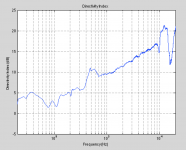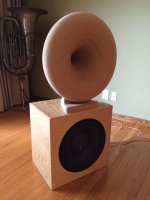Hi, Mitchba! Any chance you could repost your info with impulse response instead of step function?
Hi Lynn, my view is that a step response will show any time alignment/coherence issues, even in a two way bookshelf. A step response measure is more evenly weighted from low to high's and provides a balanced view. As you say, IR's are heavily weighted towards high frequencies and in my article on time alignment, one can see that the individual amplitude response of the HF IR is 10x greater than the midrange IR, and 100x greater than the woofer IR. So indeed, when folks are viewing a speaker system IR, the prominent amplitude view is high frequencies.
As before, starting with the IR of my Lynx Hilo AD DA in external loopback mode. Note that these measures, and the previous ones, are using REW's default settings, sweeping from 10 Hz to 24 kHz at a 48 kHz sample rate:
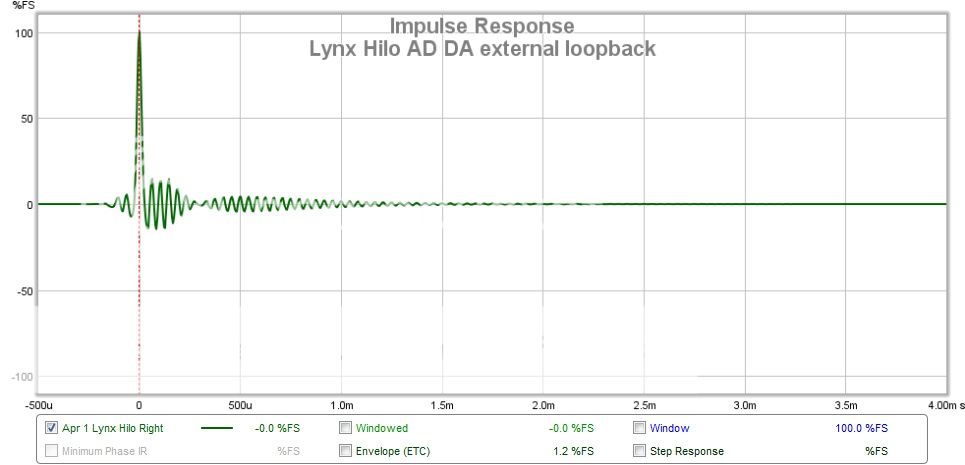
Right speaker 3 way active digital XO, time alignment, and room correction at the LP:
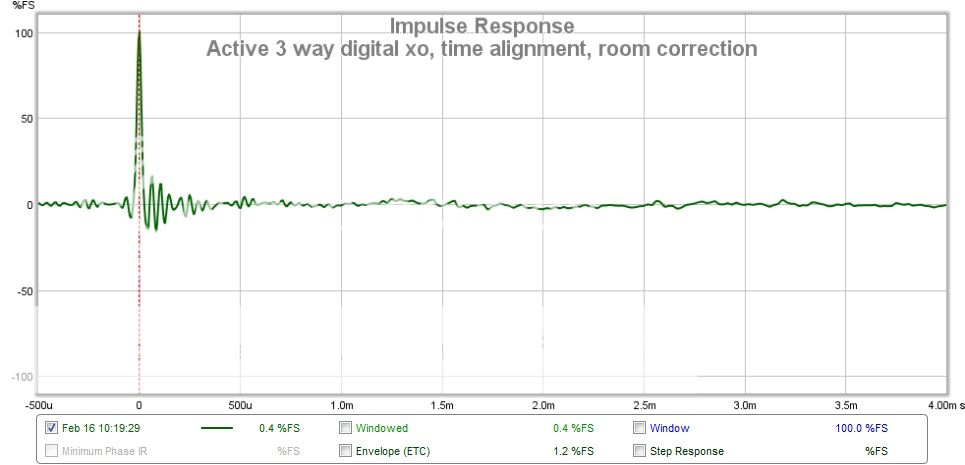
Right speaker with 3 way passive XO, not time aligned, at the LP:
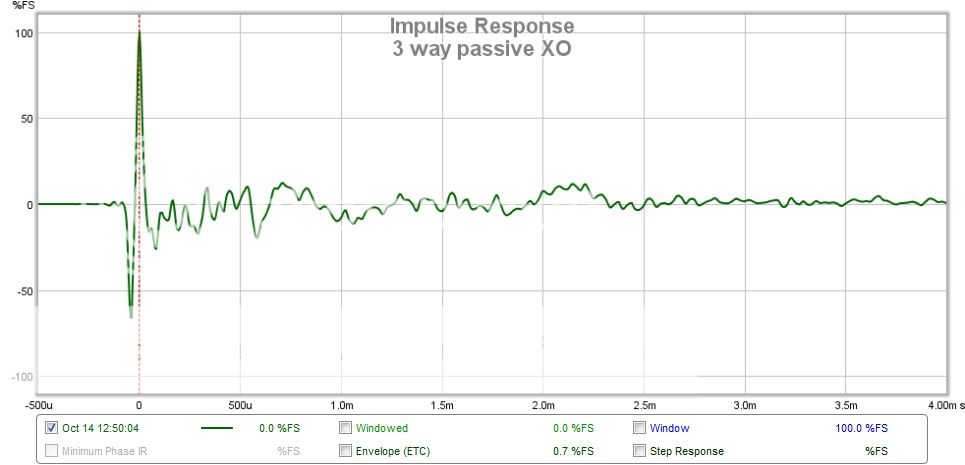
Overlay of 6 IR's at the LP around a 6' x 2' grid with digital FIR correction:
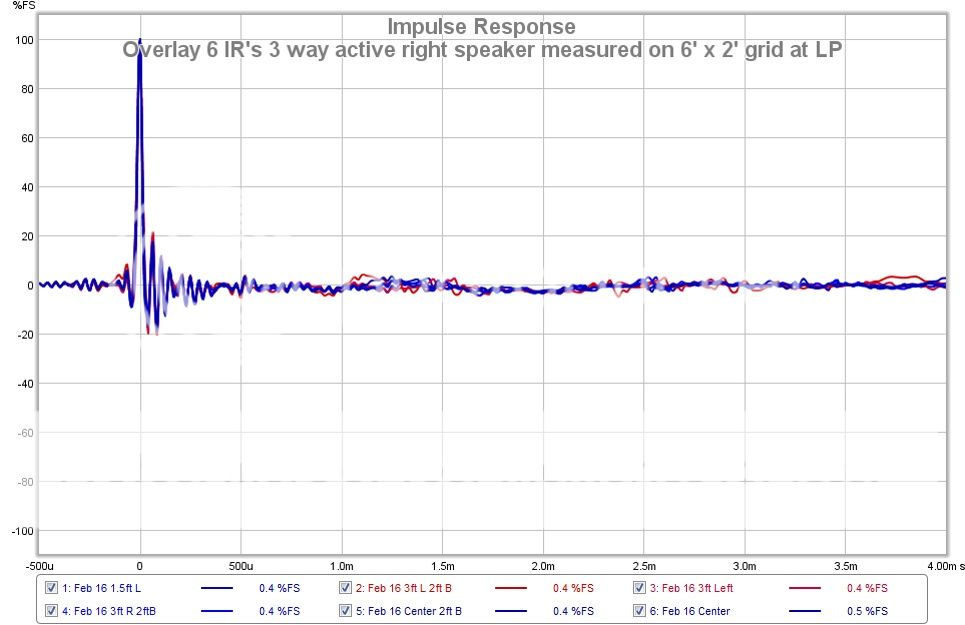
Personally, I enjoy the attributes of linear phase loudspeakers.
With respect to floor bounce, first reflection points, and such, the recommended chart is an Energy Time Curve (ETC). The rule of thumb is having any reflections -20 dB down (or greater) from the peak over the first 20 ms constitutes a good reflection free zone. Here is the ETC of my room:
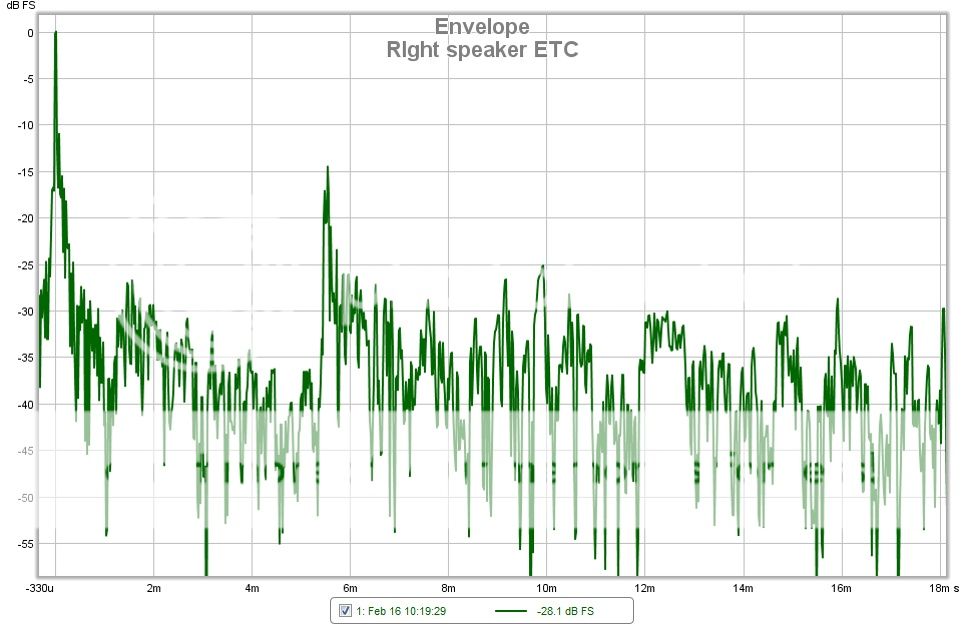
While I have done a reasonable job minimizing floor bounce, ceiling, and rear wall specular reflections, I have one last reflection close to 6 ms to take care of.
My purpose in posting here is to see if there are any better high efficiency designs than my old school (now active) 3 way that uses a Bob Crites 15" Klipsch replacement woofer in a Cornwall clone cabinet (now sealed), Selenium D405 mated to 1st gen JBL 2380a, and BMS 4540ND (response to 30 KHz) mated to QSC PL-000446GP waveguide. Your design is a contender, along with a few others, to perhaps displace my current speakers. Short of listening
So, having posted measures in kind, it would be great to see a step response (and IR) of your new design. Or better yet, please supply a REW .MDAT file and everyone can slice and dice the measures any which way to get a real profile of the performance of your speaker system. REW is free and can run both on a PC and Mac.
mitchba,
Nice impulse response graphs. The only problem I have is separating the slight ringing in the D/A and A/D from the speaker with FIR correction. They seem to track well with each other.
Thank you. I now see there is a difference in the audio device drivers I used for the before and after measures. The 3 way passive measure from 2012 was using REW's JAVA driver, which means the Windows audio subsystem is in play. The 2014 measures were using the Lynx ASIO driver, which bypasses the Windows audio subsystem:
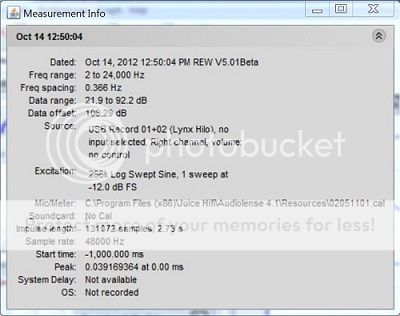
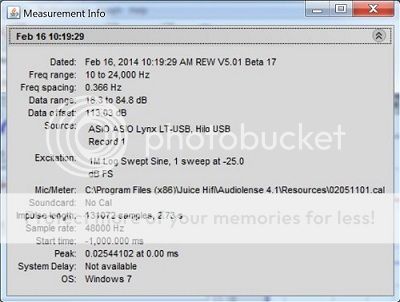
With respect to seperating the filter differences, here is an overlay of the first millisecond of both the Hilo (Red) and speaker (Blue):
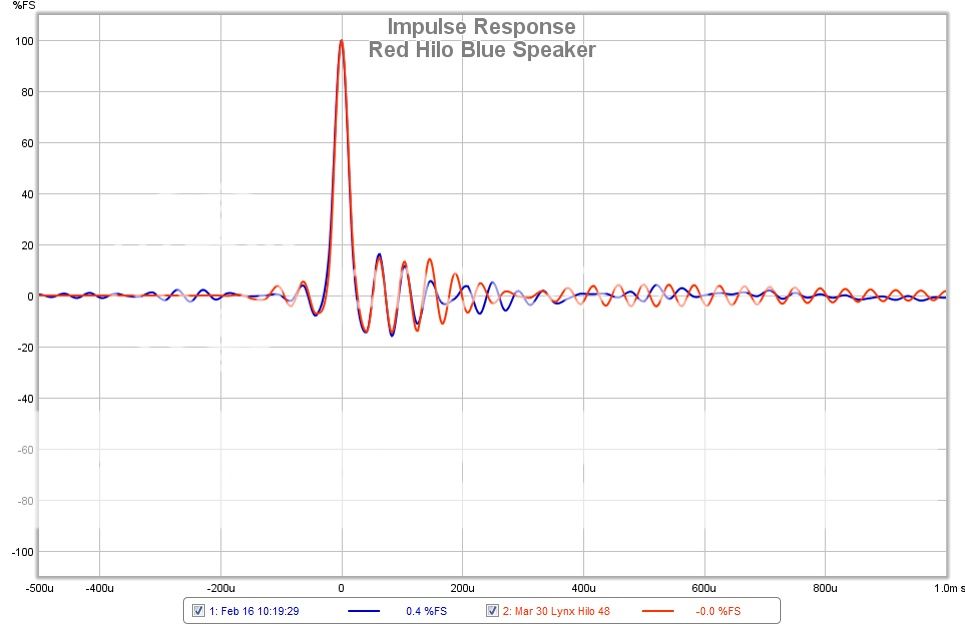
Comparison of before and after overlay Red: 3 way passive XO and Blue: active 3 way digital XO, time alignment, and room correction:
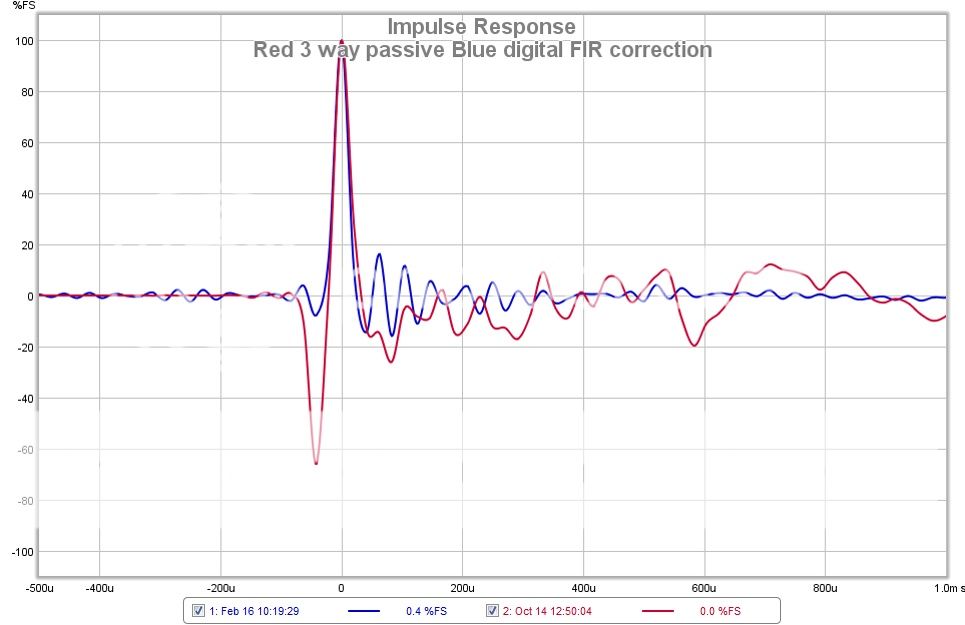
and room correction:
It is signal correction. Any electronic device can't do anything to the room.
Lynn are you talking about biamping the GPA 416? You don't think the speaker would lose some of its coherence since the GPA covers some of the lower midrange?
Thanks for latest updates Gary. Never thought I would say I was looking forward to when I can retire my Quad ESL!
Did retire mine sometime ago. They just dont have the guts to deliver what I wanted.
Sorry to hear your med condition. Listening is what it is all about to me. Live radio of live venues in particular. In the UK one can be saturated with choice concerts.having read this thread from the beginning... more or less... and now fighting cancer, I can say that my perspective has changed as to what's important in life. I used to think having high specs and impressive sound on "reference" recordings was the be all/ end all. Both before my dx and currently, I realize, across a vast cross section of classical, jazz, rock, country, you name it... there are so many uncontrolled variables in the reproduction chain prior to my pretty high end equipment chain... these swamp out all the bluster about op amp distortion, compression horn HOM's, sizzle in planar/esl, etc.
I'm off to a live jazz venue tonite .... my system, with the right source, produces and has for over a decade wide and accurate sound stage, depth, and a believable "you are there" experience; maybe not the perfect reproduction of the original, but external factors seem much more important than fussing over horn geometry, SET's, tubes vs. sand amps... all the stuff claimed to be important in the enjoyment of the sound of the listening experience.
It's mostly nonsense... the honest response should be "we just like putsing around with electronic stuff, and think the "new" sound is interesting each time we make a change...
With my projected shortened lifespan, I now find I just like to listen and enjoy what I can find that meets my level of expectation... tubes vs. ss vs. esl vs. horns, etc. seem to mean so much less now
John L.
Adjust ones system to suit these and it is a real ongoing life experience. I have always enjoyed the technical challenges and I always respect the limitations of the material and components and ensuing deigns. Perfection is not vital and is a diminishing requirement when you reach a high reproduction quality with music genres you like, whether using valves or transistors.
I prefer the quest for an intial search for the best stae of the art repro then when I think I have got close, I will stop and enjoy for a year or longer, much longer, unless new possibilities become a pressing need. Then I endeavour to create another system to last another X years. I guess Lynn is doing this and then you have time for other pursuits, not chasing the dream for ever better sound every day.
Hi Lynn, would you point again to the relevant posts describing your attempts of dipoles earlier?
Hi, Elias! I set dipoles aside after considering the equalization requirements, which conflict with the intention to use the loudspeaker with low-power triode amplifiers. In particular, seeing the detailed equalization curves for Linkwitz's speaker at one of the RMAF shows really gave me pause. The woofers had 20 dB of boost EQ in the 30~300 Hz range, and the midrange had a M-shaped EQ curve with the left side of "M" having 8 dB of boost while the right side had 6 dB of boost. No EQ was required for the dome tweeter, of course, just a highpass filter.
The reason for the "M" shaped midrange curve was to counteract the baffle peak, which fell right in the middle of the mid's working range. That got me thinking a little more about the impulse response.
In an OB with a perfect driver, you see the impulse from the front of the cone, followed by an inverted, delayed, and lowpass-filtered wave from the back of the cone. This secondary wave is responsible for the 3~6 dB baffle peak, the 6 dB/octave rolloff below that, and a series of comb-filter nulls above the baffle peak. The ideal correction would be a FIR filter, which electronically cancels the back wave (although the correction becomes less accurate as you move off-axis).
There are many speaker designers (whose work I admire and respect) who feel that competently designed amplifiers and DACs are pretty much the same, which opens the door to multi-amping with moderately-priced transistor amplifiers, computer-based digital correction, and 8-channel delta-sigma DACs. This is the mainstream approach in the pro world, and the main difference from Linkwitz is that he's using an array of opamps and equalization in the analog domain, instead of digital FIR correction.
Both approaches are a long way from the kind of system I've had for the last ten years. One DAC with expensive and hard-to-source TI/Burr-Brown PCM-1704 converters (OEM price $75 per mono channel), vacuum-tube I/V conversion, and an all-vacuum-tube amplification chain with DHT 45's for drivers and DHT 300B's for power tubes. A multichannel version of this would cost as much as a new BMW, not to mention heating up the room and requiring a full-sized equipment rack. Not going to do this, nor am I going back to transistors for music listening (although perfectly happy using them for home theater).
I'm still curious about open-back boxes filled with UltraTouch recycled cotton, which is a kind of a halfway house between an OB and a conventional closed box (lined or filled with recycled cotton). The baffle peak should be much smaller, maybe 1~2 dB, and the rate of rolloff decreased as well. With much less energy from the back wave, the equalization requirements fall inside what can done with passive crossover filters.
Jpak was asking about bi-amplification. Since the MF/HF section does not need in-band equalization, and is absurdly efficient at 112~115 dB/meter, a very minimal (and low distortion) Class A amplifier would do the job. A single-ended 45 amplifier would be ideal for the task, with a more-than-enough output of 1500 milliwatts.
Of course, once you open the door to bi-amping, there's no reason to stay with a very expensive PP DHT amplifier for the below-700 Hz duties. A generic 60-watt PP pentode (KT88, KT120, 6550) amplifier might do just as well, and you can go vintage, or build your own. If the bass unit was a true OB, though, 60 watts would probably not be enough, and you'd have to consider something like a 200-watt Class AB transistor amp. Think of it as a partial Linkwitz system.
Last edited:
Lynn,
The horrors of what you just described would make me run from the room and any idea of ever using any open back speaker. I just don't see the point at all to those systems. That makes a line array look simple in comparison even if that is not something I want either. There is nothing wrong with a closed box or vented box system and they are much easier to correct for any anomalies. A well designed horn system, providing you have the room for one, would have the least problem with amplification and equalization. If I wasn't working on small compact speaker designs that is where I would spend my time.
The horrors of what you just described would make me run from the room and any idea of ever using any open back speaker. I just don't see the point at all to those systems. That makes a line array look simple in comparison even if that is not something I want either. There is nothing wrong with a closed box or vented box system and they are much easier to correct for any anomalies. A well designed horn system, providing you have the room for one, would have the least problem with amplification and equalization. If I wasn't working on small compact speaker designs that is where I would spend my time.
I hear you, Kindhornman. I'm at a loss why OB's sound as good as they do, because I'm quite aware of the serious problems they have in the time domain. The inverted, delayed, and low-passed (by diffraction around the baffle edge) rear wave is what causes all the problems in the frequency domain. Since I'm struggling for every dB in efficiency ... those triode watts are very expensive ... throwing away 6 dB/octave in the bass isn't going to happen.
It would be nice if I had room for a pair of straight 150 Hz bass horns, but I don't. Particularly if the bass horn is acoustically time-aligned with the AH425 and compression driver; that would put the mouth of the bass horn a good distance in front of the mouth of the AH425.
---
I have been thinking of the problems associated with the change in directivity-index when a horn (any horn) is crossed over to a direct-radiator bass driver. Constant-directivity horns stay close to 90 degrees over the working range, while the JMLC is variable-directivity, but even at the lowest working frequency, the JMLC directivity is still something like 120 degrees or so. No matter what kind of horn is used, the back half of the sphere is largely dark.
In contrast, the bass driver is directive at the crossover frequency, but an octave lower, it's getting close to omnidirectional. In the space of an octave, the DI has gone from something like 4~6 to close to unity. That has to be audible, no matter what the on-axis frequency response is. Walk around a horn/direct-radiator hybrid, and you hear rumble-rumble, and no HF at all, when you walk around the back. The bass is omnidirectional while the rest of the frequency range isn't.
The only ways I can think of to make the bass range more directional (so it corresponds roughly to the lowest DI of the horn) is a pretty large bass array (which are notoriously prone to lobing), the aforementioned dipoles (with all of their problems), or a bass horn (where size, weight, and cost are traded against the cutoff frequency).
The only other way might be a cardioid bass radiator, which gets us into weird territory pretty fast. Following the example of microphones, that might involve an omni (closed-box) in close proximity to a dipole, with some tricky time and phase adjustments between the two.
It would be nice if I had room for a pair of straight 150 Hz bass horns, but I don't. Particularly if the bass horn is acoustically time-aligned with the AH425 and compression driver; that would put the mouth of the bass horn a good distance in front of the mouth of the AH425.
---
I have been thinking of the problems associated with the change in directivity-index when a horn (any horn) is crossed over to a direct-radiator bass driver. Constant-directivity horns stay close to 90 degrees over the working range, while the JMLC is variable-directivity, but even at the lowest working frequency, the JMLC directivity is still something like 120 degrees or so. No matter what kind of horn is used, the back half of the sphere is largely dark.
In contrast, the bass driver is directive at the crossover frequency, but an octave lower, it's getting close to omnidirectional. In the space of an octave, the DI has gone from something like 4~6 to close to unity. That has to be audible, no matter what the on-axis frequency response is. Walk around a horn/direct-radiator hybrid, and you hear rumble-rumble, and no HF at all, when you walk around the back. The bass is omnidirectional while the rest of the frequency range isn't.
The only ways I can think of to make the bass range more directional (so it corresponds roughly to the lowest DI of the horn) is a pretty large bass array (which are notoriously prone to lobing), the aforementioned dipoles (with all of their problems), or a bass horn (where size, weight, and cost are traded against the cutoff frequency).
The only other way might be a cardioid bass radiator, which gets us into weird territory pretty fast. Following the example of microphones, that might involve an omni (closed-box) in close proximity to a dipole, with some tricky time and phase adjustments between the two.
Last edited:
If you make the horn about the same size as the woofer (or a bit bigger for a LeCleac'h with a full round over), the DI should match pretty well through the crossover. I'd imagine that's pretty close to what you have. This is what I am listening to at the moment and the DI is almost a straight line from where it's omni at LF to whatever it is around 10k (due to using a 1.5" throat JBL driver). There's just a bump due to the vertical separation at crossover which I think I could get better in my system by massaging the crossover a bit more. I've only taken one cut at it so far and am waiting for another go until I upgrade my woofers. The horizontal match is about perfect.
Attachments
Dipole speakers have there set of problems for sure, but I do like the unboxy sound. I always feel there is a little left of that in other systems, when you compare them with dipole systems. I only find Dipole really usefull in the bas range, I feel it is easy enough to damp cabinets in the midrange, to make them sound clean. I have to mention I am not saying dipole is the best way, I have build systems with all cabinet designs.
Hi, Elias! I set dipoles aside after considering the equalization requirements, which conflict with the intention to use the loudspeaker with low-power triode amplifiers. In particular, seeing the detailed equalization curves for Linkwitz's speaker at one of the RMAF shows really gave me pause. The woofers had 20 dB of boost EQ in the 30~300 Hz range, and the midrange had a M-shaped EQ curve with the left side of "M" having 8 dB of boost while the right side had 6 dB of boost. No EQ was required for the dome tweeter, of course, just a highpass filter.
The reason for the "M" shaped midrange curve was to counteract the baffle peak, which fell right in the middle of the mid's working range. That got me thinking a little more about the impulse response.
In an OB with a perfect driver, you see the impulse from the front of the cone, followed by an inverted, delayed, and lowpass-filtered wave from the back of the cone. This secondary wave is responsible for the 3~6 dB baffle peak, the 6 dB/octave rolloff below that, and a series of comb-filter nulls above the baffle peak. The ideal correction would be a FIR filter, which electronically cancels the back wave (although the correction becomes less accurate as you move off-axis).
There are many speaker designers (whose work I admire and respect) who feel that competently designed amplifiers and DACs are pretty much the same, which opens the door to multi-amping with moderately-priced transistor amplifiers, computer-based digital correction, and 8-channel delta-sigma DACs. This is the mainstream approach in the pro world, and the main difference from Linkwitz is that he's using an array of opamps and equalization in the analog domain, instead of digital FIR correction.
Both approaches are a long way from the kind of system I've had for the last ten years. One DAC with expensive and hard-to-source TI/Burr-Brown PCM-1704 converters (OEM price $75 per mono channel), vacuum-tube I/V conversion, and an all-vacuum-tube amplification chain with DHT 45's for drivers and DHT 300B's for power tubes. A multichannel version of this would cost as much as a new BMW, not to mention heating up the room and requiring a full-sized equipment rack. Not going to do this, nor am I going back to transistors for music listening (although perfectly happy using them for home theater).
I'm still curious about open-back boxes filled with UltraTouch recycled cotton, which is a kind of a halfway house between an OB and a conventional closed box (lined or filled with recycled cotton). The baffle peak should be much smaller, maybe 1~2 dB, and the rate of rolloff decreased as well. With much less energy from the back wave, the equalization requirements fall inside what can done with passive crossover filters.
Jpak was asking about bi-amplification. Since the MF/HF section does not need in-band equalization, and is absurdly efficient at 112~115 dB/meter, a very minimal (and low distortion) Class A amplifier would do the job. A single-ended 45 amplifier would be ideal for the task, with a more-than-enough output of 1500 milliwatts.
Of course, once you open the door to bi-amping, there's no reason to stay with a very expensive PP DHT amplifier for the below-700 Hz duties. A generic 60-watt PP pentode (KT88, KT120, 6550) amplifier might do just as well, and you can go vintage, or build your own. If the bass unit was a true OB, though, 60 watts would probably not be enough, and you'd have to consider something like a 200-watt Class AB transistor amp. Think of it as a partial Linkwitz system.
You may have had the ooprtunity more than most to compare the range of formats and speakers in their optimised or acceptable repro conditions
It is likely you are one of only a few that has come nywhere close to this.
We seem all of us to have aquandary regarding PP DHT S DHT and the supporting chain that feeds into this and then the speaker congfigs with OB, TL, horn, and other speaker format ELS, Magnetic Planar sytems etc.
When one can truely make comparisons the way forward is for some a no brainer. It can get so good with most syustems properly optimised that there are many ways to get there as they say.
But in any audiophiles quest they may get to what they feel is the settling point for a system whre they will put developments on hold for an indeterminate period.
I think it is important to give many of the posters or readers a feeling that they can reach a decent goal and stop. Even if in the end we do not stop as it may be more than just the music that we enjoy.
I guess there are many suckers like us that just cannot give up or just get to a point where they say finally this is it, at least for the present.
At least with the publicity of all the ongoing rovings of audiophiles we will keep getting rennaisances as time goes by.
If you make the horn about the same size as the woofer (or a bit bigger for a LeCleac'h with a full round over), the DI should match pretty well through the crossover. I'd imagine that's pretty close to what you have. This is what I am listening to at the moment and the DI is almost a straight line from where it's omni at LF to whatever it is around 10k (due to using a 1.5" throat JBL driver). There's just a bump due to the vertical separation at crossover which I think I could get better in my system by massaging the crossover a bit more. I've only taken one cut at it so far and am waiting for another go until I upgrade my woofers. The horizontal match is about perfect.
Wow! Very elegant system, I'm impressed. Looks gorgeous, too! Your measurements show a very smooth increase in DI, as I'd expect from a JMLC profile. One of things I like about a JLMC is the very smooth edge of the pattern, with a soft decay, and the smooth change in DI with increasing frequency. It is very much not a PA speaker.
What I was mentioning in the previous post was the DI between the LF range (100 Hz to 500 Hz) versus the DI in the MF/HF range (1 kHz to 5 kHz). This is most obvious when you play music and walk around the speaker. A JMLC has the merit of no sharp changes as you walk around (with conical horns, I hear a blink-on and blink-off effect at the edge of the pattern), but things are very dull indeed when you're directly behind the speaker.
Why do I worry about extreme off-axis sonics? Well, the first 20 milliseconds are dominated by first, second, and a few third reflections from the back and side walls, and the floor and ceiling. The reflection off the back and side walls are from extreme off-axis emission angles, 90 degrees or more. The net result is that most reflections off the back and side walls are much duller-sounding than the first-arrival wave from the front of the loudspeaker.
The total room spectra (all of the reflections summed over 3 to 20 mSec) are duller sounding than the on-axis response of the loudspeaker, since most of the reflections originate from emission angles that are well off-axis, and these have little HF content. (Conical horns are strong to +45 and -45 angles, but drop like a stone outside that, and emission at +90 and -90 are well down in level, and sometimes very uneven in response.)
This creates a minor problem in subjectively equalizing the speaker so it sounds flat. Although the direct sound dominates the overall spectral impression, the room reflections play a role as well. I equalize a speaker so pink noise sounds flat, but that won't necessarily be the right EQ for music. Pink noise is a good method for subjectively assessing low-level CSD resonances, but it doesn't tell you anything about transient response. That's where a series of clicks or certain types of percussive music (including piano) may be more informative.
It's all very nice to have smooth first-arrival curves, but that may not correlate too well with the subjective spectral impression, since that's a psychoacoustic response to the first-arrival sound and integration of the first group of reflections. I also suspect the relative importance of the room spectra may depend on the type of music, as well as preferences of the listener, although I have no hard evidence one way or the other.
We've all had a lifetime of listening to artificial sounds from loudspeakers, so we may expect loudspeakers to sound a certain way, and not like it if that expectation is not met. This pre-set expectation is also different for listeners of different ages, since the sound of hifi has changed over the decades.
The music itself has changed; recordings made in the last decade are ferociously "hot" and sizzly compared to recordings made in the Fifties and early Sixties. Younger listeners grew up with all-digital sources, lots of music with MP3 and Dolby Digital lossy-compression, and PA and movie theater speakers with titanium compression-driver diaphragms. I grew up listening to Zenith FM table radios, mono all-tube hifi systems, and Altec A2 and A4 speakers in theaters with 70mm projectors and six-channel all-analog magnetic soundtracks. That's a very different sonic experience.
Last edited:
I'm at a loss why OB's sound as good as they do, because I'm quite aware of the serious problems they have in the time domain. The inverted, delayed, and low-passed (by diffraction around the baffle edge) rear wave is what causes all the problems in the frequency domain.
To me, it looks like you are approaching to whole problem from completely wrong direction. Sorry to say.
The betterness of dipole over monopole bass in a small room is in the signal modulation domain.
First, we must ask a question:
What is music ? Because music is what we are reproducing, isn't it.
The answer is: Music is a series of signals having temporal modulations resulting a pseudorandom like envelope. Music is information.
When dipole and monopole are placed in a small room and are analysed in the modulation domain, it is seen the dipole has much better modulation transmission. That is the ability to reproduce the modulation of the original source signal. Exactly what we need.
Elias Pekonen Home Page - Dipole Bass vs Monopole Bass
Why is modulation transmission capability important ? Because it is the means we perceive the information of sound. We extract the modulation (demodulate) from the carrier signals (tones) and perceive it as music.
A good introduction to the subject:
Neural Processing of Amplitude-Modulated Sounds, P. X. JORIS, C. E. SCHREINER, AND A. REES, Physiol Rev 84: 541-577, 2004; 10.1152/physrev.00029.2003
physrev.physiology.org/content/84/2/541.full.pdf
Some quotes:
"We address the question whether specialized neural mechanisms exist to extract AM information, and thus whether consideration of the modulation domain is essential in understanding the neural architecture of the auditory system. The available evidence suggests that this is the case. Peripheral neural structures not only transmit envelope information in the form of neural activity synchronized to the modulation waveform but are often tuned so that they only respond over a limited range of modulation frequencies."
"The picture that emerges is that temporal modulations are a critical stimulus attribute that assists us in the detection, discrimination, identification, parsing, and localization of acoustic sources and that this wide-ranging role is reflected in dedicated physiological properties at different anatomical levels."
This is pretty interesting, and could indicate the principal function of auditory system is to extract the modulation, the information, out of the acoustic signal.
Certainly it would be helpful if the modulation is preserved in quality and in quantity in the audio reproduction, especially with loudspeakers and room. Why make it harder for the brain?
.
Elias,
Very impressive work! After hearing Gary Pimm's dipole bass implementation, I don't need further convincing of what can be accomplished using that approach. Perhaps my bass boxes could be reconfigured as dipoles.
Lynn, I think you should come up for a listen.
Gary Dahl
Very impressive work! After hearing Gary Pimm's dipole bass implementation, I don't need further convincing of what can be accomplished using that approach. Perhaps my bass boxes could be reconfigured as dipoles.
Lynn, I think you should come up for a listen.
Gary Dahl
Elias,
Very impressive work! After hearing Gary Pimm's dipole bass implementation, I don't need further convincing of what can be accomplished using that approach. Perhaps my bass boxes could be reconfigured as dipoles.
Lynn, I think you should come up for a listen.
Gary Dahl
Listening is the final arbiter is it not. Does the baffle need a 20 Hz sub woofer? or is it part or all done in the cross over - easy peasy ?
Lynn et. al,
As anything in audio there are always tradeoffs and also decisions we have to make about what we are looking for. While I understand the thinking of an omnidirectional sound system we also have to think about the original source recording in all of this. I have never been in a recording studio that was done with omnidirectional sound, that is not what was intended. Now if you are attempting to recreate the sound field of an orchestral sound field or even the sounds you would hear while walking around a trio or small acoustical ensemble while outside without any structure around them that is a very distinctively different situation. I just don't see how you could ever recreate both of those types of sounds with the same system, and I see no way to do that in an enclosed space.
Now we get to the point of how we listen to music. In my eye most of the time people do that while sitting in a passive way, staying in one place, not necessarily moving or walking around, getting up and down or anything resembling those things. So do I really want or care if I have high frequency dispersion behind my speakers, probably not because of the delayed reflections that would change the first arrival of sound. Now I must admit that I don't listen to orchestral music, that is not the music I listen to, for those that do things could be different.
I understand your like for the JMLC type of horns and your dislike for CD horns, those to me do not belong in a typical listening room, they are not to my liking, to much depends on the room treatment for them to sound right and the eq required to make them sound flat is not something that I desire.
I started my interest in sound working in the PA field and using nothing but horn loaded systems from high to lows, A2's and many of them standing together for the bass and large format horn above those. Of course the distance we listened at was much greater than you could ever achieve in a normal listening room and there were many problems with simple passive crossovers and other amplification limitations of the time, but this was my nexus for sound at the time. I developed a good understanding of horns from that start and patented new horns way back then that were based on the idea of radial horns and the problems that I could see in the earlier implementations of such. At that time I also developed cone driver radial horns that were shown at an earlier AES convention. I understood where the problems were coming from in the original designs and could see the answers in new manufacturing methods and materials along with changes of topology. I think you would have to think of a blending of both the ideas that Earl Geddes exposes and the ideas of the JMLC horns and that was my thinking of the time. Earl patented some ideas that I had proposed before he did but didn't publish for general consumption, he and I were on the same track, but we took a very different approach to how we looked at the problems, he from the mouth of the waveguide and myself from the diaphragm forward. He and I have talked privately and it was interesting how we agreed on the problems but took very opposite ways of viewing the problems, the same result would be the end product though he chose to go with the cd type of arrangement while I still am not happy with that approach.
I started a manufacturing company to make my waveguides but due to other factors ended up using that facility and equipment to develop many other products in other industries instead, it was a change of direction that taught me much but as I look back now I wished that I had stayed focused on audio as that was really my passion to begin with. I look today and see so many things that I worked on in those years, ATM machines, the first touch screens in the early 80's. solar panels for Arco Solar, now Siemens solar and so many other products and materials applications including high speed composites manufacturing which is still not really understood today.
I still have sitting eight throat sections for double 18" bass horns that I have made for some people in Pro Audio applications that had a 1/4 wave mouth size of 75 to 95hz cutoffs that I think I will complete and sell to some small band or such, they sounded like nothing else I have heard before or since but to put something like that in a room is not something that most would do, perhaps some of the crazies, and I use that term with endearment here, would put those in a room with a complete system but I don't have a room to put them in today. I must say when these were used in a PA application at an outdoor live event that four of these enclosures replaced 16 John Meyer enclosures and were so much more efficient that the Meyer boxes were just turned off, you could not hear the difference. I was standing in front of one when unbeknownst to me one of the sound guys decided to crank one up while I was directly in front of the enclosure and it was the first and only time that I thought that I almost had my hearing taken out by a bass enclosure, to put it nicely I was a bit pissed! So I do appreciate all the work going on to make horn loaded systems sound nice for use in a home.
I still have enclosures molded in the shape that is my avatar and I will in the not to distant future sell the ones I still have as very high end audio art pieces. Today my work has been directed at a new series of self powered consumer speakers with a new look and taking so much of what I have learned in the last close to forty years of audio pursuit. Not necessarily for those who would build ultimate systems, but something that I think will bring very close to a true audiophile sound to the masses.
As anything in audio there are always tradeoffs and also decisions we have to make about what we are looking for. While I understand the thinking of an omnidirectional sound system we also have to think about the original source recording in all of this. I have never been in a recording studio that was done with omnidirectional sound, that is not what was intended. Now if you are attempting to recreate the sound field of an orchestral sound field or even the sounds you would hear while walking around a trio or small acoustical ensemble while outside without any structure around them that is a very distinctively different situation. I just don't see how you could ever recreate both of those types of sounds with the same system, and I see no way to do that in an enclosed space.
Now we get to the point of how we listen to music. In my eye most of the time people do that while sitting in a passive way, staying in one place, not necessarily moving or walking around, getting up and down or anything resembling those things. So do I really want or care if I have high frequency dispersion behind my speakers, probably not because of the delayed reflections that would change the first arrival of sound. Now I must admit that I don't listen to orchestral music, that is not the music I listen to, for those that do things could be different.
I understand your like for the JMLC type of horns and your dislike for CD horns, those to me do not belong in a typical listening room, they are not to my liking, to much depends on the room treatment for them to sound right and the eq required to make them sound flat is not something that I desire.
I started my interest in sound working in the PA field and using nothing but horn loaded systems from high to lows, A2's and many of them standing together for the bass and large format horn above those. Of course the distance we listened at was much greater than you could ever achieve in a normal listening room and there were many problems with simple passive crossovers and other amplification limitations of the time, but this was my nexus for sound at the time. I developed a good understanding of horns from that start and patented new horns way back then that were based on the idea of radial horns and the problems that I could see in the earlier implementations of such. At that time I also developed cone driver radial horns that were shown at an earlier AES convention. I understood where the problems were coming from in the original designs and could see the answers in new manufacturing methods and materials along with changes of topology. I think you would have to think of a blending of both the ideas that Earl Geddes exposes and the ideas of the JMLC horns and that was my thinking of the time. Earl patented some ideas that I had proposed before he did but didn't publish for general consumption, he and I were on the same track, but we took a very different approach to how we looked at the problems, he from the mouth of the waveguide and myself from the diaphragm forward. He and I have talked privately and it was interesting how we agreed on the problems but took very opposite ways of viewing the problems, the same result would be the end product though he chose to go with the cd type of arrangement while I still am not happy with that approach.
I started a manufacturing company to make my waveguides but due to other factors ended up using that facility and equipment to develop many other products in other industries instead, it was a change of direction that taught me much but as I look back now I wished that I had stayed focused on audio as that was really my passion to begin with. I look today and see so many things that I worked on in those years, ATM machines, the first touch screens in the early 80's. solar panels for Arco Solar, now Siemens solar and so many other products and materials applications including high speed composites manufacturing which is still not really understood today.
I still have sitting eight throat sections for double 18" bass horns that I have made for some people in Pro Audio applications that had a 1/4 wave mouth size of 75 to 95hz cutoffs that I think I will complete and sell to some small band or such, they sounded like nothing else I have heard before or since but to put something like that in a room is not something that most would do, perhaps some of the crazies, and I use that term with endearment here, would put those in a room with a complete system but I don't have a room to put them in today. I must say when these were used in a PA application at an outdoor live event that four of these enclosures replaced 16 John Meyer enclosures and were so much more efficient that the Meyer boxes were just turned off, you could not hear the difference. I was standing in front of one when unbeknownst to me one of the sound guys decided to crank one up while I was directly in front of the enclosure and it was the first and only time that I thought that I almost had my hearing taken out by a bass enclosure, to put it nicely I was a bit pissed! So I do appreciate all the work going on to make horn loaded systems sound nice for use in a home.
I still have enclosures molded in the shape that is my avatar and I will in the not to distant future sell the ones I still have as very high end audio art pieces. Today my work has been directed at a new series of self powered consumer speakers with a new look and taking so much of what I have learned in the last close to forty years of audio pursuit. Not necessarily for those who would build ultimate systems, but something that I think will bring very close to a true audiophile sound to the masses.
AuroraB,
I hope that isn't something you took from what I wrote, I would rather use that type of horn,JMLC, than a constant directivity horn myself. I think that the premise of the cd horns requires more room treatments to work well, I don't think many people want to have to treat a room to the extent that a cd horn would entail.
I hope that isn't something you took from what I wrote, I would rather use that type of horn,JMLC, than a constant directivity horn myself. I think that the premise of the cd horns requires more room treatments to work well, I don't think many people want to have to treat a room to the extent that a cd horn would entail.
- Home
- Loudspeakers
- Multi-Way
- Beyond the Ariel
